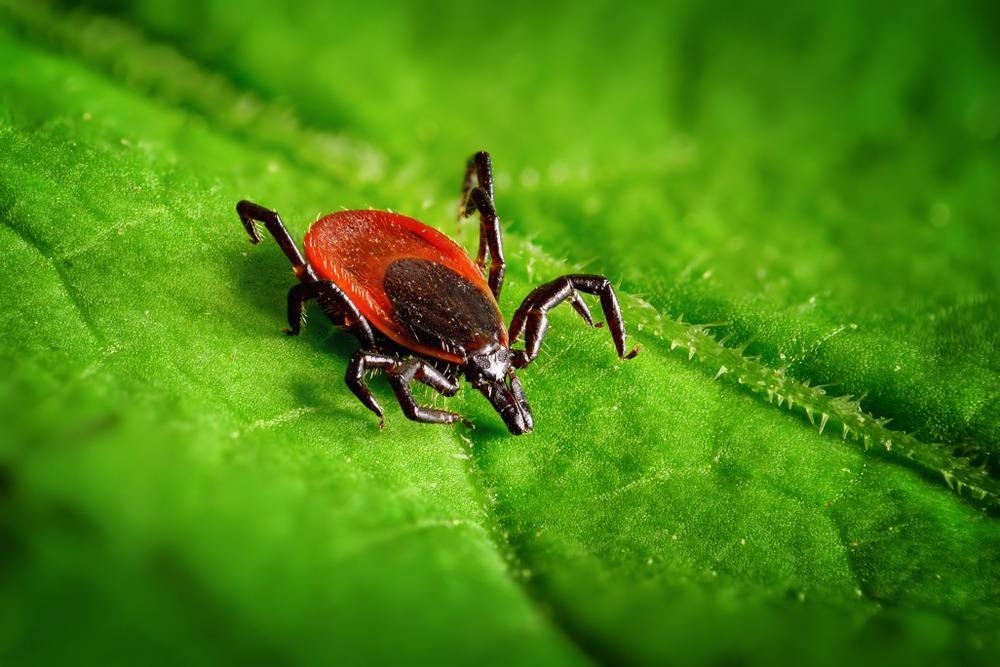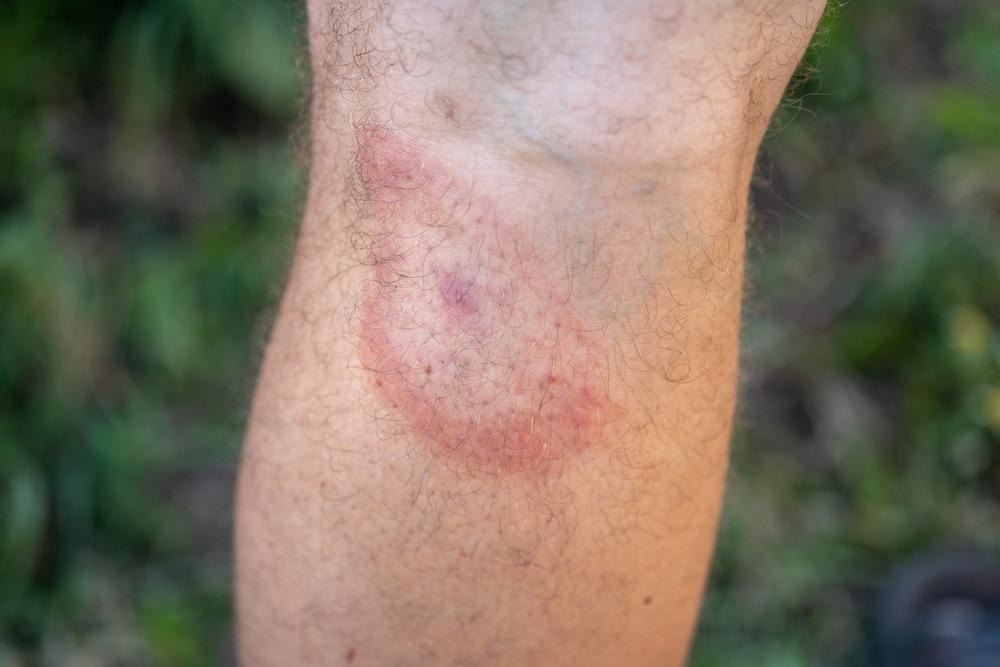Due to the vast variety of ticks found throughout the world, several different tick-borne diseases have been identified to date. Some of the most commonly diagnosed tick-borne diseases in the United States include Lyme disease, babesiosis, ehrlichiosis, Rocky Mountain Spotted Fever, and anaplasmosis.

Tick. Image Credit: Smileus/Shutterstock.com
An overview of tick bites
Throughout the world, a total of 900 species of ticks exist and reside in a wide range of habitats from dry areas to very humid climates. These acarids can be classified as hard ticks, which are otherwise known as Ixodidae and account for almost 700 tick species, or soft ticks, which are also known as Argasidae and account for 193 tick species.
Ticks are hematophagous species that strictly feed on blood; thus, their survival is entirely dependent upon their ability to feed on hosts. Although wild animals are the primary hosts for ticks, humans can also experience tick bites when they visit a tick’s habitat.
Once a tick finds a humid and warm spot on the skin of an animal or human, the inset will pierce the epidermis with their chelicerates, which share a similar appearance to sharp blades, and settle into the skin with their hypostome. Thereafter, the tick will secrete a thick and cement-like substance that firmly retains its position on the skin to prevent it from dropping off.
The tick saliva itself exerts various pharmacological activities in the host including coagulation and pain inhibition, all the while inhibiting local immune responses in the host against the tick bite. Although tick saliva itself can cause an allergic reaction to arise at the bite site, various pathogens such as bacteria, viruses, and parasites can also be passed onto the host and induce a tick-borne disease.
Lyme disease
Throughout the United States, one of the most common tick-borne diseases is Lyme disease, which is caused by Borrelia burgdorferi. In fact, current estimates indicate that up to 500,000 cases of Lyme disease are reported each year.
Between 70% and 80% of patients with Lyme disease will experience a rash of erythema migrans within one to two weeks of being bitten by a tick. The tick bite associated with Lyme disease is often referred to as a “bull’s eye” rash in 30-40% of cases due to its appearance resembling a target. Notably, most patients who are diagnosed with Lyme disease do not recall being bitten by a tick.
In addition to the dermatological reactions that can arise at the site of the tick bite, Lyme disease can also cause a wide range of acute symptoms including neurological symptoms in 10-15% of patients that can include facial nerve palsy, lymphocytic meningitis, and radiculopathy. Untreated Lyme disease can also lead to arthritis in about 30% of individuals within several months of the original infection.
Notably, between 10-20% of individuals diagnosed with Lyme disease will experience persistent post-treatment symptoms that are sometimes referred to as chronic Lyme disease. Some of the symptoms associated with chronic Lyme disease include fatigue, myalgias, arthralgia, and memory loss.

The tick bite associated with Lyme disease is often referred to as a “bull’s eye” rash in 30-40% of cases due to its appearance resembling a target. Image Credit: Alexey Androsov/Shutterstock.com
Babesiosis
An Ixodes tick that carries the protozoa Babesia and subsequently bites a human can transmit the tick-borne disease known as babesiosis. Within the United States, babesiosis is most commonly diagnosed in the northeastern and upper midwestern states. Although a majority of babesiosis cases are reported in the United States, over the past fifty years, an increasing number of babesiosis cases have also been identified throughout parts of Asia and Europe.
The clinical manifestations of babesiosis can vary greatly, ranging from asymptomatic infection to fulminating disease that can result in death. Typically, the Babesia microti will have an incubation period between one and six weeks after a tick bite. Some of the most common acute symptoms after this period will include the gradual onset of malaise and fatigue, as well as a range of other symptoms including chills, sweats, anorexia, headache, and myalgia.
Immunocompromised patients, particularly those with advanced age, asplenia, HIV/AIDS, cancer, or cardiac, hematologic, or liver comorbidities, are at an increased risk of severe babesiosis. Some of the complications of this severe infection can include severe anemia, acute respiratory distress syndrome (ARDS), disseminated intravascular coagulation, congestive heart failure, renal failure, and coma.
Ehrlichiosis and anaplasmosis
The most common etiologic agent that causes human monocytotropic ehrlichiosis (HME) is Ehrlichia chaffeensis, whereas Anaplasma phagocytophilum is often responsible for human granulocytic anaplasmosis (HGA). Both HME and HGA share similar clinical presentations, which can range from fever and headache to hematologic abnormalities like leukopenia and thrombocytopenia and elevated liver enzymes.
Notably, about 20% of patients diagnosed with HME can also exhibit various neurological abnormalities that can lead to the development of meningitis or meningoencephalitis, with some patients even experiencing seizures and coma. When HME is diagnosed in children and the central nervous system (CNS) is involved, it is uncommon for long-term neurological effects to arise; however, some potential long-term symptoms of HME in this patient population can include cognitive delays, fine motor impairment, and persistent foot drop.
As compared to HGA, HME is also a much more severe infection, as about 62% of cases will require hospitalization with 17% of patients experiencing life-threatening complications of the disease. Like babesiosis, immunocompromised patients are also at an increased risk of both severe disease and death when diagnosed with HME.
References
- Boulanger, N., Boyer, P., Talagrand-Reboul, E., & Hansmann, Y. (2019). Ticks and tick-borne diseases. Medecine et Maladies Infectieuses 49(2); 87-97. doi:10.1016/j.medmal.2019.01.007.
- Tick-Borne Diseases [Online]. Available from: https://www.cdc.gov/niosh/topics/tick-borne/default.html.
- Syndman, D. R., & Hu, L. (2021). Lyme disease. Medicine 49(12); 747-750. doi:10.1016/j.mpmed.2021.09.004.
- Krause, P. J. (2019). Human babesiosis. International Journal for Parasitology 49(2); 165-174. doi:10.1016/j.ijpara.2018.11.007.
- Ismail, N., & McBride, J. W. (2017). Tick-Borne Emerging Infections: Ehrlichiosis and Anaplasmosis. Clinics in Laboratory Medicine 37(2); 317-340. doi:10.1016/j.cll.2017.01.006.
Further Reading
Last Updated: Jun 1, 2022